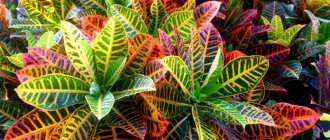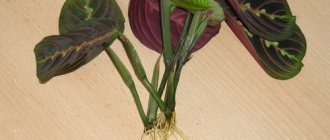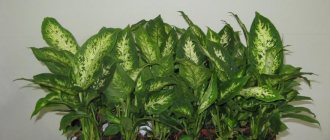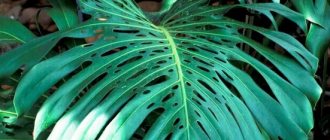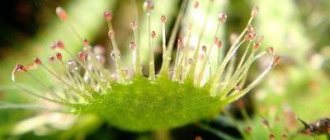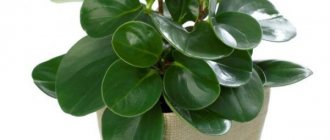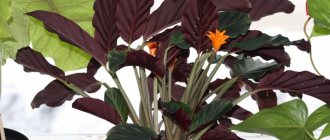Nolina is a houseplant with a very unusual appearance that immediately attracts attention. Another name for nolina is bocarnea (1), and gardeners often call it “bottle tree.” Indeed, the nolina stem has a characteristic expansion at the bottom, so it resembles a bottle. The “crown” of nolina consists of thin long leaves with a leathery surface, which grow in a bunch at the top of the trunk and give the plant a resemblance to a palm tree.
Nolina is native to Mexico and the southern United States. There it lives on poor drying soils, which is the reason for its unusual appearance. The thickening in the lower part of the trunk is a reservoir for storing moisture, and the specific shape of the leaves is needed so that the plant loses much less moisture by evaporation from their surface.
Types and varieties of nolina
Only one type of nolina flower is grown indoors - Nolina recurvata. It can reach a height of about 2 m, but usually remains more compact in indoor conditions.
On sale you can find plants with different types of formation: a single trunk with a “panicle” at the end or a branched one, each shoot of which has its own crown. These are not different varieties of nolina, but plants of the same species; the differences between them are created artificially during the growing process.
The youngest nolins look like bulbs sitting in the ground with a low crown; very often they are sold in pots of 3 pieces - over time, they most often grow together into one trunk, which gradually increases in height and takes on a characteristic “bottle” appearance.
How to properly care for the crop?
Nolina is an exotic plant that can adapt to any conditions, but in order for the tree to please the eye with its luxurious appearance, you should still adhere to some recommendations for caring for it.
Air temperature and humidity
Since the natural habitat of this plant is the desert, it loves warmth very much. In summer, it is optimal to maintain the temperature within +21-26 degrees, and in winter not lower than +7. If there is no precipitation in the summer, you can take the pot of nolina into the garden. Air humidity is not a particularly significant indicator for this type of flora; you just need to exclude as much as possible the possibility of water getting on the surface of the trunk, so as not to cause the process of rotting.
Lighting
But lighting is very important for the plant. When placing on a windowsill, it is advisable to choose the south or southwest side. When determining where to place a flower pot on the floor, you should find the brightest space. You can place nolina in direct sunlight - it is not afraid of them, but a lack of light will quickly lead to withering of the leaf part and loss of color. In addition, the plant will constantly reach towards the light source, and in order to prevent the trunk from bending, it is advised to turn the container in a circle by about 40-50 degrees once a week.
Watering mode
More than anything else, excess moisture is harmful to nolina. Excessive watering is practically the only way to destroy a bottle tree, because in nature it is used to receiving moisture extremely rarely. The best option would be to irrigate at two-week intervals in the spring and summer and stop moistening the soil in winter. Any water collected in the pan must be drained immediately. During the cold season, minimal watering is possible only if the plant trunk begins to lose elasticity.
Favorable soil for growing and fertilizing
Recurvate is ideally suited to a ready-made substrate intended for succulents. You can only add a little expanded clay to it to make the soil airier. As a top dressing, it is good to use activated or charcoal, or a mixture for the same succulents. The frequency of applying such fertilizers is 3 weeks.
If all of the above rules are followed, nolina will look like a well-groomed and healthy plant with a dense green part and a powerful, strong trunk, which will undoubtedly please any gardener.
Caring for nolina at home
Caring for a nolina flower is considered simple, but an inexperienced gardener may encounter a number of problems associated primarily with watering and wintering conditions for the plant (2).
Priming
As already mentioned, under natural conditions nolina lives on depleted soils, so fertile and dense soil is contraindicated for it. The soil for nolina should first of all be light, loose, water- and breathable. Ready-made compositions include mixtures for succulents and cacti, which can be enriched with charcoal or vermiculite.
If you prefer to prepare the soil yourself, then for nolina you will need a mixture of coarse sand, peat and garden soil, where sand should predominate.
Lighting
Nolina needs bright, diffused lighting and a fairly long daylight period. Direct sun, especially in summer, can harm it, but the lack of light does not have the best effect: in the shade, the nolina trunk stretches out, remains too thin and can become deformed, bending in the direction of the light.
Throughout the year, including during winter dormancy, the amount of light should be approximately the same, so caring for nolina in winter should include additional illumination with a phytolamp.
It is also useful to sometimes turn the pot so that the trunk does not bend and the crown does not become “one-sided,” since even on a light windowsill the illumination is never uniform.
Temperature
During the growing season, the plant thrives at room temperature, although in extreme heat (above 30 °C) the nolina flower may require additional care.
In the warm season, nolina can be taken out onto the balcony or terrace, taking care of protection from rain and drafts. In winter, the plant needs a rest period at a temperature of about 10 - 12 ° C, and the temperature should be lowered gradually, without sudden changes. Nolina can do without “hibernation” if the room temperature is more than 18 ° C, but the absence of a dormant period leads to the fact that the plant develops worse and lives less than it could.
Humidity
Nolina usually tolerates room humidity levels.
Plants that have not entered the dormant period may suffer from dry air in winter if they are located near heating devices or the humidity in the room is really abnormally low. In such cases, it is recommended to place the pot in a tray with damp expanded clay, pebbles or sphagnum.
Spraying and washing are not recommended; wiping the leaves with a damp cloth to remove dust is possible.
Watering
Watering is a very important point in caring for nolina. It tolerates dry soil more easily than waterlogging, so water the plant only after the earthen ball has completely dried out. Watering should be rare, but plentiful: frequent, scanty watering leads to elongation of the trunk and loss of decorativeness of the plant. Experts recommend watering the plant by immersing the pot in a basin of water so that the soil is well saturated with moisture. The water is then allowed to drain through the drainage holes and drained from the pan.
If nolina is provided with a cold winter, the plant is not watered at all or is done very rarely, only if the flower clearly shows a moisture deficiency: the trunk loses its elasticity and wrinkles.
If nolina overwinters at room temperature (18 °C and above), the watering regime remains the same as in summer, or a little less often, depending on the room temperature. As a rule, the warmer the conditions, the faster the earthen ball dries out and the more often it should be watered.
Water for irrigation should be moderately warm and low in salts, so it is advisable to settle tap water or pass it through a filter.
Fertilizers
Nolina can be fed with complex mineral fertilizers for indoor plants in half the dosage; it is advisable to use liquid formulations. Special fertilizers for cacti and succulents are also suitable.
Photo: pixabay.com
Feeding
To feed nolina, it is advisable to use liquid formulations and apply them immediately after watering once every 3-4 weeks.
It has been noticed that with a deficiency of nutrients, nolina forms a larger and thicker trunk, and with sufficient and excessive feeding, it forms abundant foliage.
Trimming
The plant does not need pruning; you just need to remove dried leaves as part of your normal nolina care.
Transfer rules
If you bought nolina in an unsuitable pot, it is advisable to replant it as quickly as possible. Prepare everything you need and start transplanting.
- Remove the plant from the old pot and examine the roots. Rotten areas must be cut off and the wounds powdered with crushed charcoal. Dry the nolina slightly before planting if the soil was too wet.
- Place drainage at the bottom of the pot and pour a small mound of soil, compacting it slightly. Then the nolina is installed vertically, the roots are straightened and covered with soil.
- Make sure that the trunk does not go deep when planting, otherwise it may rot. Only roots should be in the ground. Some people try to bury part of the trunk because there is damage on it; this absolutely should not be done. Over time, the damaged area will certainly be covered with bark.
- After planting, the soil around the plant is compacted to give the pot stability. If the weight of the container with soil is not enough to hold the tree vertically, you can place several decorative stones on the surface of the soil.
- After completing the procedure, the “elephant’s foot” is placed in a shaded place and is not watered for 2-3 days. If the purchased plant was flooded and the trunk began to rot, you will have to stop watering for 2 weeks. The supply of moisture inside the caudex will help Nolina survive this time safely.
Reproduction of nolina at home
Nolina can be propagated in two ways: by seeds and shoots.
Seeds. This option is only possible from purchased material - at home, nolina does not bloom and, accordingly, does not set seeds. Nolina seeds can be found at large suppliers of planting material; they are usually sold in packages of 3 - 5 pieces. But with this method of propagation, you need to take into account that not all seeds can sprout.
Before sowing, nolina seeds can be soaked in any growth stimulant for 24 hours. Then they are sown in a moistened mixture of peat and sand (1:1) and sprinkled with a thin layer of soil (the thickness of the layer is approximately equal to the size of the seed itself). The container with the crops is covered with film or glass, placed in a warm place and provided with round-the-clock lighting with a phytolamp, daily ventilation and regular moistening of the substrate as soon as it dries.
The average time for emergence of seedlings is from 3 to 5 weeks. After this, remove the film from the container and grow the plants in a warm, bright place for 2 - 4 weeks. Then they are planted in separate pots filled with substrate for adult plants, and watered as the earthen ball dries out. Young plants do not need fertilizing; they begin to be applied only after six months to a year. It is very important for young nolins to receive enough light, so it is advisable to supplement them with additional lighting.
By shoots. This is a rarer method due to difficulties in obtaining planting material. Nolina is capable of producing daughter shoots from dormant buds at the base of the trunk, but this happens infrequently.
If the plant has formed side shoots, they are allowed to grow a little, then cut off at the very trunk with a sharp, clean knife. The sections are treated with activated carbon. It is better to root the separated shoot in the ground. To do this, it is treated with Kornevin or another root formation stimulator, then planted in a moistened substrate of peat, sand and perlite or vermiculite (1:1:1). Cover the container with a transparent lid (for example, half a plastic bottle or glass jar) and keep it in a warm place in bright light. The mini-greenhouse is ventilated daily, the soil is moistened as the top layer dries.
A sign of rooting is the appearance of young leaves. When the shoot takes root, the mini-greenhouse is removed. The plant can be replanted into a substrate for adult nolina after a few months.
Description
Nolina - what kind of plant is this?
Belongs to the species Agavaceae. Latin name: Nolina. Unofficial names: bottle tree and decorative Bocarnea.
The plant is distributed in the southern part of America in the states of Texas, Arizona, California, and New Mexico.
In the wild it has the shape of a miniature tree. At the base the trunk widens greatly.
It serves to conserve water that feeds the plant.
Since this representative of the flora grows in arid desert states, it has acquired the ability to retain moisture during prolonged drought.
This expanded base is called a caudex - a swelling.
As moisture and nutrients are used, the thickening decreases. At the same time, folds appear in the bark. During periods of rainfall, Nolina's reserves are replenished, and the caudex again increases in volume.
The crown of the plant is powerful and very dense. The leaves are narrow, elongated, very hard. The leaves have a miniature evaporating surface. They are shaded by a trunk of caudex water.
The reservoir protects the surface from overheating. Therefore, it is generally accepted that all parts of the flower are perfectly adapted to growing in arid areas.
Nolina (Bocarnea) photo:
Here you can read an interesting article about one of the types of bottle tree “Nolina Recurvata” (Bocarnea Recurvata) and the features of caring for it.
Nolina transplant at home
In the first 3 - 4 years, nolina grows very actively, so it needs a transplant every year. Plants older than this age are replanted less frequently, every 2 - 3 years, and very mature nolins (more than 10 years old) may no longer need replanting.
The nolina flower is usually replanted in late February or early March, before the plant comes out of dormancy. The pot for replanting should be the same depth as the previous one, but 2 - 3 cm wider - the root system of nolina is superficial and grows only in width.
If the plant overwintered in a warm place and did not stop growing during the winter, stop watering 7 - 10 days before replanting so that the substrate dries well. Then the nolina is carefully removed from the pot; the remains of the old earthen lump are not removed from the roots - you can only shake off the soil that crumbles on its own. When transferring to a new pot, you need to ensure that the plant, after filling with soil, is at the same depth as before.
Immediately after transplantation, nolina cannot be watered - this can only be done after a few days.
Choosing the right pot and soil
When choosing a pot for bocarnea, you need to take into account the presence of caudex, the type of root system and the height of the trunk. Tall and narrow vessels are not suitable for the “elephant’s foot” plant; such a container can easily tip over after transplantation. It is necessary that the pot is wide and low, with several drainage holes. In such a container, water will not stagnate, and the soil will be able to dry out quickly, which will prevent rotting of the trunk. When transplanting, the pot is filled 1/3 with expanded clay drainage.
The soil for this tree should be light, loose, and breathable. You can buy ready-made substrate for succulents at a garden center - this is the easiest option. To facilitate the penetration of oxygen into such soil, you can mix it with several handfuls of expanded clay. If you make up the soil mixture yourself, keep in mind that it should consist of clay soil, leaf humus, sand and expanded clay in a ratio of 2:2:1:1. For additional nutrition and disinfection, pieces of charcoal can be added to the soil.
Nolina diseases
Trunk rotting. This is the most common nolina disease. The reason is excess moisture in the substrate, that is, simply overflow. Signs of rot are softening of sections of the trunk, the appearance of weeping dark spots. Most often, the disease affects the lower part of the trunk above ground level.
Photo: pixabay.com
At the first signs of disease, watering is stopped until the earthen coma is completely dry, the diseased parts of the trunk are cut out with a clean tool, the wounds are dried and treated with 1% copper sulfate or a solution of potassium permanganate. After this, it is advisable to transplant the plant into fresh soil. If this is not possible, the soil in the pot is spilled with any suitable fungicide (for example, the same potassium permanganate in the form of a weak solution).
Rules for forming a decorative flower
The exoticism of the bottle tree is due to the unusual structure of the trunk and the original “crown” of a mop of long leaves. Improper care of nolina at home can not only deprive the plant of all its decorative properties, but also destroy a valuable specimen. Only the correct agricultural technology for indoor plants is the key to obtaining an unusual plant with a thick trunk base and lush palm-shaped greenery.
Bokarneya forms a thick trunk to accumulate moisture. The bottle tree requires bright sunlight and infrequent but generous watering. Nolina, grown in partial shade or shade, has a thin, sloping trunk and dull leaves. Excessively frequent watering, which deprives the plant of periods of “drought,” is unnatural for a desert dweller. The bottle trunk loses volume during the dormant period as the plant sells its moisture reserves. Nolina will successfully restore trunk volume after emerging from dormancy.
Flower growers from Holland often pinch the growing point of bocarnea to awaken dormant buds. In this way, spectacular nolina “palm trees” with several spherical shocks of greenery on one thick trunk are obtained. The bottle tree grows slowly, like many succulents. The crown of the bottle tree is constantly renewed; drying of the lower leaves is a natural process. To increase the decorative appearance of the plant, it is recommended to trim them carefully.
Nolina pests
The nolina flower has no specific pests, but at very low air humidity it can be attacked by common pests of indoor plants: scale insects, mealybugs and spider mites.
Since the crown of nolina is small, and the trunk is not particularly interesting to parasites, the problem is most often solved by washing the plant with green or laundry soap. If there are a lot of pests on the nolina flower and the plant is severely affected, you will have to resort to agrochemicals and use Aktara (3) or any available insectoacaricide suitable for indoor plants.
The main mistakes when growing nolina and parasite attacks
Nolina is characterized by the fact that it is practically not susceptible to attack by dangerous pests. Most growing problems arise as a result of improper care. Thus, external signs of deteriorating plant health can indicate to the grower his mistakes.
- Dryness of leaves and loss of their elasticity occurs due to excessively dry air and elevated temperatures. Moving to a cooler location will solve this problem.
- A wrinkled stem indicates a lack of water and quickly recovers after replenishing moisture.
- A reduction in the growth rate of the trunk signals that the tree needs nutrients. To correct the situation and resume development, it is enough to fertilize the soil.
- The falling of leaves and turning them brown indicates excess watering and the possibility of plant rotting. If the trunk is already covered with rot, reducing the flow of moisture is not enough - you must immediately cut out all the affected areas, sprinkle the cut areas with activated carbon and dry the trunk and root system well for 10 hours, then plant it in new soil.
If it happens that the roots of the nolina have completely rotted, you can thoroughly sanitize its trunk and re-root the plant by planting it in a substrate for succulents or cacti. Watering is resumed gradually. After some time, the bottle tree will give new roots.
Although the appearance of pests is extremely rare for nolina, if the plant is constantly in uncomfortable conditions of low light or excessive watering, it may well be attacked by scale insects, thrips or spider mites. They will take advantage of the tree's reduced immunity and attack it. It is the spider mite that is most common, since in the hot summer it infests on other indoor flowers and has the opportunity, if the opportunity arises, to move to a weakened crop.
To save the plant from harm, when the first signs of pest activity appear, you should wash the leaves with a soapy solution using cotton pads. In an advanced situation, when such a harmless method does not help, you will need to resort to the use of insecticides. The drug is used in accordance with the description in the annotation.
If you follow very simple rules for growing bottle trees, they will not cause any trouble, but will decorate their habitat and delight others with their exceptional exoticism.
Signs and superstitions
There is a popular belief that this plant brings wealth and prosperity to the house. It’s not for nothing that pachira is called the money tree. Its presence in an apartment has a beneficial effect on a person’s mood and energy, directs him to success in business and protects him from troubles and material problems.
Correctly placed according to the Eastern teachings of Feng Shui, the money tree serves as a powerful tool in attracting good luck and wealth, so it should be placed in the southeastern sector of the home. You can place an image of water or an artificial waterfall nearby, and decorate the plant itself with red ribbons or hearts to enhance the magical effect.
It is not recommended to place the plant on the north side, because according to Feng Shui, this blocks the flow of money and leads to the ruin of the tree owners.
The flowering of pachira is considered a very lucky sign, symbolizing quick enrichment. You should also make wishes during this period.
Watering
In the warm season, water with clean water that has stood for 2 days. The liquid should be poured in a thin stream without touching the barrel. In winter, you should water rarely or stop watering altogether so that it does not begin to rot.
Pachira does not require a lot of moisture. The water should be soft, at a temperature not lower than +20 °C.
If you are going on vacation
To organize watering during a long absence, you can place a pot with a bottle tree in a basin or bath with water at the bottom 2 cm high and pour wet expanded clay at the bottom and sides of the flower pots.

